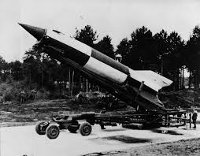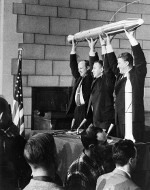Wernher von Braun: Rocketry and Space Program Pioneer
Wernher von Braun was a pioneering scientist in the field of rocketry. He was part of both Nazi Germany's missile program and America's space program. He was born in Wirsitz, Germany, on March 23, 1912, into an upper-class family. His father served as Minister of Agriculture in the Weimar Republic, and his older brother later served in the West German Government. An early fan of science fiction stories of space travel, von Braun struggled early in school but found a new desire to excel, especially in mathematics and physics, after reading the writings of Hermann Oberth, who is considered to be the father of German rocketry. He went on to work with Oberth at the German Society for Space Travel, while studying at the Berlin Institute of Technology. Von Braun earned a bachelor's degree in aeronautical engineering from that school and then earned a doctorate in physics from the University of Berlin, in 1934. He was also an accomplished musician, mastering both the cello and the piano. 
The German government outlawed nonmilitary rocket tests, and so von Braun joined the military in order to continue his work. He was named technical director at the Peenemunde research station and, applying the teachings of Oberth and the studies of America's rocketry godfather Robert Goddard, von Braun, who had earlier developed liquid fuel rockets, helped developed Nazi Germany's vaunted V-2 ballistic missile. 
This rocket could carry a payload of warheads up to 500 miles. It was used during the later part of the war, first in September 1944. The German war machine sent more than 5,000 toward Great Britain; only one-fifth of those arrived, but the death toll was huge: 3,000 people (with thousands more injured). The Allied occupation of the beaches of Normandy on D-Day began a process that, among other things, culminated in the seizure of the launch sites for those V-2 rockets. Von Braun himself surrendered to Allied forces near the end of the war, but only after his own government had arrested him and charged with sabotaging the very weapons program that he had helped develop. He and his brother, Magnus, and von Braun's whole team surrendered as well. The American government transported von Braun to the U.S. and, rather than prosecute him for war crimes, put him to work in the American rocketry and missile program. He went back to Germany briefly in 1947, to get married. He brought his wife, Maria Luise von Quistorp, and her parents to America when he returned. The couple eventually had three children. In 1952, he
Von Braun was one of a number of scientists who went feverishly to work after the Soviet launch of the satellite Sputnik in October of 1957. His team designed and built Explorer 1, America's first satellite in space. 
He switched to the National Aeronautics and Space Administration (NASA) in 1960 and served as director of the Marshall Space Flight Center, overseeing development of the Saturn rockets that would eventually launch the Apollo capsules into space. After a two-year stint as NASA's deputy associated administrator for planning, he left the space agency, in 1972, and entered the private sector, as vice president of Fairchild Industries, an aerospace company. He later founded the National Space Institute and was an advocate for a human mission to Mars. Among the honors he received was the National Medal of Science, in 1975. He had also, in the 1950s, worked with Walt Disney on a series of educational films called Man in Space. Doctors diagnosed him with kidney cancer in 1973. He continued to work, but his health slowly deteriorated. He died on June 16, 1977. He was 65. 
Von Braun's legacy is a complicated one. He did serve the seekers of world domination Nazis who ruled Germany with two iron fists for more than a decade, but he said that he did so because it was the only way to continue to pursue his career in rocket design. He knew that the V-2 rockets were the product of forced labor. He also knew of the concentration camps that killed millions of people but insisted that he could do nothing to help without jeopardizing his own life. |
|
Social Studies for Kids
copyright 2002–2026
David White



 was named technical director of the U.S. Army Ballistic Missile Agency. Among the rockets that he helped build were the Redstones, which served as the launch vehicles for
was named technical director of the U.S. Army Ballistic Missile Agency. Among the rockets that he helped build were the Redstones, which served as the launch vehicles for 
